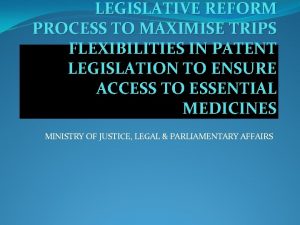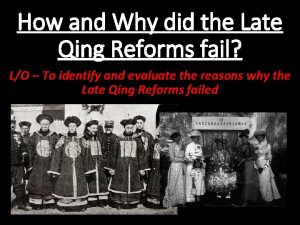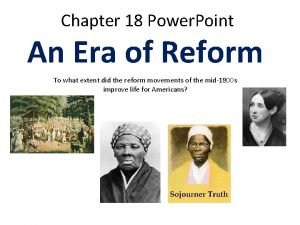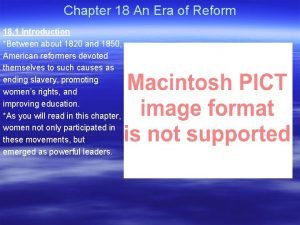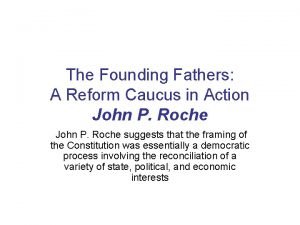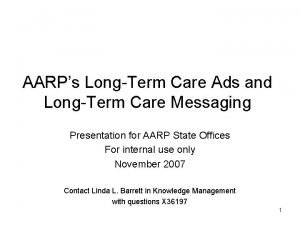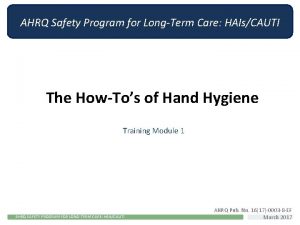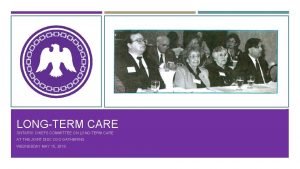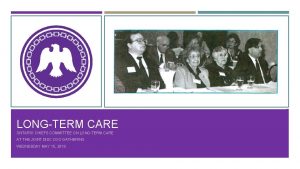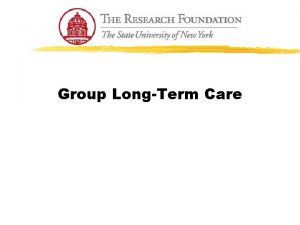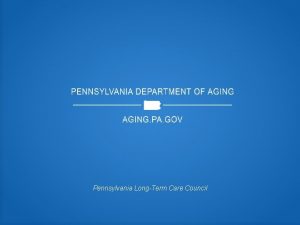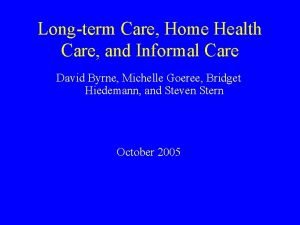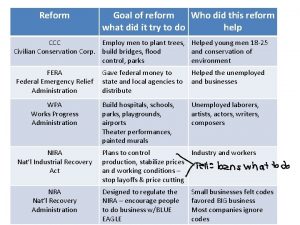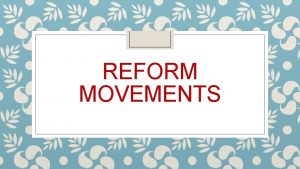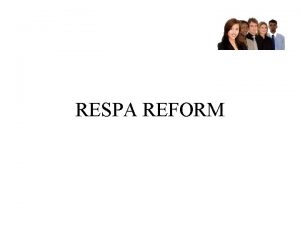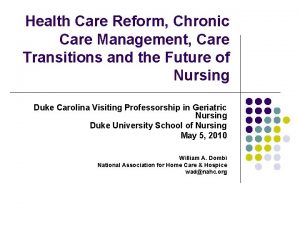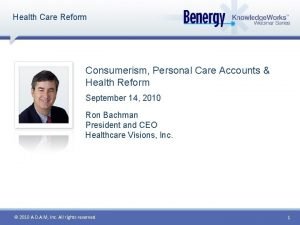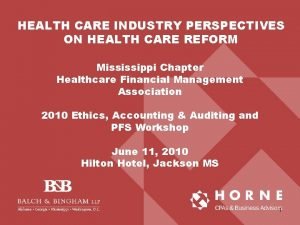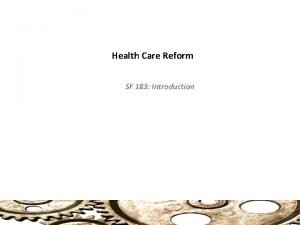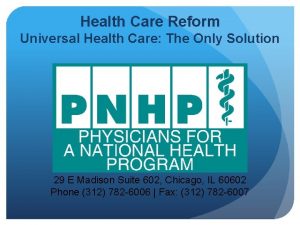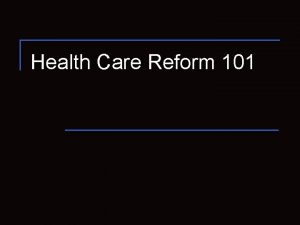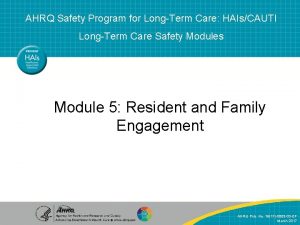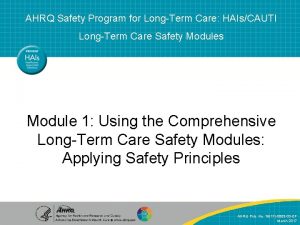US Health Care Reform Week Four LongTerm Care




































- Slides: 36

US Health Care Reform Week Four: Long-Term Care: What Makes It So Different and Difficult Bill Scanlon For Osher Lifelong Learning Institute November 2010 November 8, 2010 Health Care Reform Week Four OLLI 1

Overview • What is it? • How is it provided? • How is it currently financed? – Medicaid – Private LTC Insurance • PPACA and the Community Living Assistance Services and Supports Act (CLASS) • Challenge besides Financing November 8, 2010 Health Care Reform Week Four OLLI 2

What’s Different • Importance of preferences • Very little insurance • Underuse • Requires more than money November 8, 2010 Health Care Reform Week Four OLLI 3

Long-Term Care Assistance with everyday activities that one is unable to perform due to the presence of a disability or impairment • Activities of Daily Living (ADL) – – – Bathing Dressing Mobility Transferring Toileting Eating November 8, 2010 • Instrumental Activities of Daily Living (IADL) – – – Going Places Shopping Cooking Housework Managing Money Supervision Health Care Reform Week Four OLLI 4

What causes functional limitations? • Developmental disabilities • Trauma • Chronic diseases or conditions • Aging November 8, 2010 Health Care Reform Week Four OLLI 5

Percent of the adult population that needs LTC rises with age Source: Feder, Komisar, & Friedland (2007). Note: This and subsequent population charts exclude children. 6

Nonetheless, over two fifths of adults who need LTC are under age 65 Source: 8, 2010 Feder, Komisar, & Friedland. Health (2007). November Care Reform Week Four OLLI 7

LTC Provided in Multiple Settings – Nursing Home – Assisted Living Facility – Other Group Residential Setting--Retirement Home/ Senior Housing/CCRC/Foster Care Homes – Personal Residence November 8, 2010 Health Care Reform Week Four OLLI 8

Most adults who need LTC live in the community, especially under 65 Source: 8, 2010 Feder, Komisar, & Friedland. Health (2007). November Care Reform Week Four OLLI 9

Most adults in the community who need LTC receive unpaid help Source: Feder, Komisar & Friedland 2007 November 8, 2010 Health Care Reform Week Four OLLI 10

Many people go without needed LTC Among community adults who need LTC Needs Met 80% Source: Feder, Komisar & Friedland 2007; based on data from 1994 -1997. November 8, 2010 Health Care Reform Week Four OLLI 11

How much LTC risk does an individual face? Risk at age 65 of needing LTC before death Percent who will need some LTC Average duration, all people turning 65 Source: Kemper, Komisar, & Alecxih (2006 ) November 8, 2010 Health Care Reform Week Four OLLI 69% 3 years 12

Length of time needing LTC varies significantly for persons over 65 Years Needing LTC Source: Kemper, Komisar, & Alecxih (2006). November 8, 2010 Health Care Reform Week Four OLLI 13

When extensive services are needed, they can be costly • Nationwide average prices (in 2009) – Nursing home (private room): $79, 900 per year – Assisted living: $38, 000 per year – Home care aide: $21 per hour (20 hrs/week = $21, 900 per year) – Adult day services: $67 per day • Prices vary among, and within, locations Source: The 2009 Met. Life Market Survey of Nursing Home, Assisted Living, Adult Day Services, and Home Care Costs. November 8, 2010 Health Care Reform Week Four OLLI 14

Lifetime LTC Spending Percent of Persons 65 in 2005 Source: Kemper, Komisar, and Alecxih, “Long-term Care over an Uncertain Future, ” Presentation at Academy Health, June 2005 November 8, 2010 Health Care Reform Week Four OLLI 15

Medicaid and out-of-pocket are the main payers of LTC Private Health and Long. Term Care Insurance ($22. 3 billion) 12% Other Public ($6. 2 billion) 3% Medicaid ($119. 0 billion) 62% Out-of-Pocket ($43. 5 billion) 23% Total in 2008 = $191. 1 billion Source: O’Shaughnessy 2010. November 8, 2010 Health Care Reform Week Four OLLI 16

Medicaid • Insurance after the catastrophe of impoverishment against further catastrophe • Historically, essentially funded only nursing home care – Motivated by fear of woodwork effect – Perceived as an “institutional bias” • States have strictly controlled number of nursing home beds to limit Medicaid spending – Controls have resulted in over 1 million fewer beds today than projected November 8, 2010 Health Care Reform Week Four OLLI 17

Medicaid (Cont. ) • 1981 law created ability to waive entitlement and resulted in states increasing offerings of at -home services • Widespread variation in benefits available (State, local and possibly case-worker level) November 8, 2010 Health Care Reform Week Four OLLI 18

Medicaid spending for LTC, by type of service ICF-MR = intermediate care facilities for people with intellectual or developmental disabilities. Source: Burwell, Sredl & Eiken 2009; data are from fiscal year 2008. November 8, 2010 Health Care Reform Week Four OLLI 19

Medicaid LTC programs vary widely among states Medicaid LTC Spending per State Resident with Income Below 200% of Poverty Level Home and Community Based Services Average of 5 Highest States U. S. Total Average of 5 Lowest States Average of 5 Highest States Source: Feder, Komisar & Friedland 2007. Amounts shown are for fiscal year 2005. November 8, 2010 Health Care Reform Week Four OLLI U. S. Total Average of 5 Lowest States 20

Private Insurance • Policies marketed for about 25 years • Insurers reluctant due to uncertainty of lifetime risk and concern over consumer demanding services rather than needing services • Initial policies unduly restricted benefits • NAIC Model Statute and Regs/ Major insurers entering market improved policy offerings November 8, 2010 Health Care Reform Week Four OLLI 21

Few people have private long-term care insurance • About 7 million people have private LTCI – About 3% of people age 20+; about 10% of people age 65+ • Most policies pay for home-based & nursing home care; some also cover assisted living & adult day • Price depends on features and age when first purchased – Typically sold as individual policies November 8, 2010 Health Care Reform Week Four OLLI 22

Why is the private long-term care insurance market limited? • “Underwriting” means many people can’t purchase it – One study estimated 28% of people age 65 -69 • Demand is low – – Consumer confusion, lack of knowledge Difficult to navigate individual market Expensive Concerns about stability of premiums and insurer, benefit adequacy November 8, 2010 Health Care Reform Week Four OLLI 23

Long-Term Care: What is it? Long-term care is a range of medical and/or social services designed to help people who have disabilities or chronic care needs. Services may be short- or long-term and may be provided in a person's home, in the community, or in residential facilities. ---Dept. of Health and Human Services November 8, 2010 Health Care Reform Week Four OLLI 24

Confusion 2006 AARP Survey of Persons 45 and over • 59 %--Medicare pays for extended nursing home stays • 52%--Medicare pays for assisted living facilities November 8, 2010 Health Care Reform Week Four OLLI 25

Medicare covers post-acute services (not LTC) • Home health care benefit – Emphasis on skilled nursing and therapy services – Provides part-time or intermittent services – Must be homebound & need periodic skilled nursing or therapy • Skilled nursing facility care benefit – Covered after a 3 -day hospital stay – Must need daily skilled nursing or therapy service – 100 -day maximum November 8, 2010 Health Care Reform Week Four OLLI 26

Federal efforts to increase the number of purchasers • Federal tax incentives, e. g. , – Itemized deduction of medical expenses, deduction for self-employed – Benefits exempt from taxation for qualified policies • Information: Own Your Future campaign and National Clearinghouse for Long-Term Care website • The Partnership for Long-Term Care program – “Partnership” policyholders can keep more of their assets and become Medicaid eligible after receiving their policy’s benefits • Waiting period for Medicaid eligibility after asset transfers increased • FEHBP group offering Have had little effect on number of purchasers November 8, 2010 Health Care Reform Week Four OLLI 27

LTC Insurance Monthly Premiums FEHB Program Policy has $200 per day benefit for 3 years with a 90 day waiting period Type of Inflation Protection 5% Increase each year Option to Purchase More Coverage in the Future 45 $139 $36 55 $203 $65 65 $317 $129 75 $524 $342 Age at Purchase November 8, 2010 Health Care Reform Week Four OLLI 28

Community Living Assistance Services and Supports (CLASS) Act • Included in PPACA • Establishes federally-administered self financed insurance program to help pay for LTC November 8, 2010 Health Care Reform Week Four OLLI 29

CLASS Enrollment Likely to begin in 2012 or 2013 Strictly voluntary Age 18 or older Must be actively employed and have earnings Employers may choose to enroll workers, deduct premiums automatically, with employee opt-out • Alternative enrollment process for people whose employers do not participate • • • November 8, 2010 Health Care Reform Week Four OLLI 30

CLASS Premiums • Program is to be self-financing from premiums and earnings over 75 -year horizon • Premiums will depend on age at enrollment and year but not other factors—no underwriting • Premiums will not be increased unless needed to assure program solvency • Premiums continue after initial enrollment • Nominal premiums for employed students, poor November 8, 2010 Health Care Reform Week Four OLLI 31

Eligibility for CLASS Benefits • Premiums: Must have paid for at least 5 years and currently be paying premiums • Work: Must have earnings sufficient for one quarter of Social Security coverage ($1, 120) in 3 out of first 5 years of enrollment • Functioning: Must be unable to perform 2 or 3 activities of daily living (TBD), or equivalent November 8, 2010 Health Care Reform Week Four OLLI 32

Benefits • Daily cash benefit – Secretary of HHS to develop benefit plan – Scaled to level of functional impairment (2 to 6 levels) – Average benefit of at least $50 a day—inflation indexed • Advice and assistance counseling November 8, 2010 Health Care Reform Week Four OLLI 33

Financing • Concept viable; details matter – Work test for eligibility is a concern • CBO: Assuming initial average premium of $123 a month and average benefit of $75 a day, CLASS will be self-financing over 75 years – Is premium too high to attract many enrollees? • CMS Actuary: “Serious risk that the problem of adverse selection will make the CLASS program unsustainable. ” November 8, 2010 Health Care Reform Week Four OLLI 34

Financing is only half the problem • Consumers need help finding reliable qualified caregivers November 8, 2010 Health Care Reform Week Four OLLI 35

Questions October 18, 20 10 Health Policy Reform Week One--OLLI 36
 Kernel longterm
Kernel longterm Years solitary confinement
Years solitary confinement Week by week plans for documenting children's development
Week by week plans for documenting children's development Continuum of care reform
Continuum of care reform Pros and cons of 4 day school week
Pros and cons of 4 day school week Health and social care component 3 health and wellbeing
Health and social care component 3 health and wellbeing Health and social care values unit 2
Health and social care values unit 2 Levels of nursing care primary secondary tertiary
Levels of nursing care primary secondary tertiary Sonia deluanay
Sonia deluanay 4 eyes assessment
4 eyes assessment The spirit of reform lesson 1
The spirit of reform lesson 1 Was the tva a relief recovery reform
Was the tva a relief recovery reform Religion sparks reform chapter 8
Religion sparks reform chapter 8 When was the education reform movement
When was the education reform movement Reform movements 1800s
Reform movements 1800s Reform 10.sınıf tarih
Reform 10.sınıf tarih Law reform process
Law reform process Land reform definition
Land reform definition Land tenure reform law
Land tenure reform law Late qing reform
Late qing reform Was the tva a relief recovery reform
Was the tva a relief recovery reform Grade 12 geography settlement
Grade 12 geography settlement Define the word reform
Define the word reform Democratic reform and activism
Democratic reform and activism Chapter 10 section 1 democratic reform and activism
Chapter 10 section 1 democratic reform and activism Religion sparks reform chapter 8
Religion sparks reform chapter 8 Chapter 23 lesson 3 nationalism unification and reform
Chapter 23 lesson 3 nationalism unification and reform Tci an era of reform answer key
Tci an era of reform answer key An era of reform chapter 18 answer key
An era of reform chapter 18 answer key The ferment of reform and culture
The ferment of reform and culture Compras y vandalas
Compras y vandalas Besra in education
Besra in education Antebellum reform apush
Antebellum reform apush Alauddin khilji agrarian reform
Alauddin khilji agrarian reform Fha new deal relief recovery reform
Fha new deal relief recovery reform Relief recovery reform
Relief recovery reform The founding fathers a reform caucus in action
The founding fathers a reform caucus in action
















